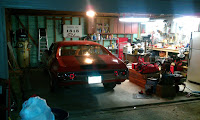 Yet, I wonder how much is a product of the house archetype of northern European culture? In my own experience I never lived in a place with attic and basement. Sometimes there were crawl spaces, but staircases steep or narrow never lead to any of them. Rather, in my phenomenology , staircases mostly separated the shared spaces of the family, the kitchen, dining room, living room, from the private spaces, the bedrooms and full bathrooms. Downstairs served as the transition from the public to the family – the first line of defense to one’s potential solitude. Whereas an invitation upstairs, was an invitation to intimacy – think Mae West’s “Come up and see me sometime.” As such, stairs were things snuck up late at night, climbed lightly avoiding the creaking step, and done in secrecy – though secrets much different than the secrets of the basement, erotic secrets, secrets of love or conspiracy.
Yet, I wonder how much is a product of the house archetype of northern European culture? In my own experience I never lived in a place with attic and basement. Sometimes there were crawl spaces, but staircases steep or narrow never lead to any of them. Rather, in my phenomenology , staircases mostly separated the shared spaces of the family, the kitchen, dining room, living room, from the private spaces, the bedrooms and full bathrooms. Downstairs served as the transition from the public to the family – the first line of defense to one’s potential solitude. Whereas an invitation upstairs, was an invitation to intimacy – think Mae West’s “Come up and see me sometime.” As such, stairs were things snuck up late at night, climbed lightly avoiding the creaking step, and done in secrecy – though secrets much different than the secrets of the basement, erotic secrets, secrets of love or conspiracy.I wonder if the Car Culture of America transforms some of the phenomenology in the garage. The garage has replaced our basement as a place to tinker unseen. Often windowless cluttered with objects banned from the house proper, here is where we American’s dream of entrepreneurial pursuits, or the next road trip. How many men have “shops” in their garage? It is a masculine creative space, where an old fridge keeps a few beers cold and a pin-up calendar displaying femininity through a filter of testosterone. The garage is a place of men, and of boys coming to age – a place where things are fixed or built before they are ready to be revealed.
My houses have been mostly horizontal; perhaps they were all tall, but decided to lay down and rest a bit, the parts all still there, but recumbent and a little more at ease than their East Coast and European cousins.







No comments:
Post a Comment